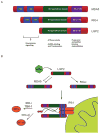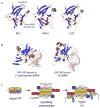Sensing of viral nucleic acids by RIG-I: from translocation to translation
- PMID: 21496944
- PMCID: PMC3155743
- DOI: 10.1016/j.ejcb.2011.01.015
Sensing of viral nucleic acids by RIG-I: from translocation to translation
Abstract
The innate immune system is a first layer of defense against infection by pathogens. It responds to pathogens by activating host defense mechanisms via interferon and inflammatory cytokine expression. Pathogen associated molecular patterns (PAMPs) are sensed by specific pattern recognition receptors. Among those, the ATP dependent helicase related RIG-I like receptors RIG-I, MDA5 and LGP2 sense the presence of viral RNA in the cytoplasm of host cells. While the precise PAMPs and functions of MDA5 or LGP2 are still unclear, RIG-I senses predominantly viral RNA containing a 5'-triphosphate along with dsRNA regions. Here we review our current knowledge of how these PAMPs are sensed and integrated by RIG-I, and how RIG-I's innate immune function can be used in translational medical approaches.
Copyright © 2011 Elsevier GmbH. All rights reserved.
Figures



References
-
- Akira S, Uematsu S, Takeuchi O. Pathogen recognition and innate immunity. Cell. 2006;124:783–801. - PubMed
Publication types
MeSH terms
Substances
Grants and funding
LinkOut - more resources
Full Text Sources
Other Literature Sources
Medical
Molecular Biology Databases

